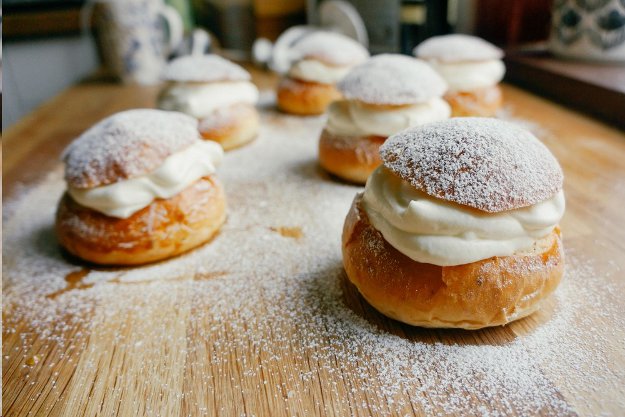A Brief History of the Doughnut

Who doesn’t love a fresh, hot doughnut? While artisanal doughnuts with unconventional flavors have been trending the last few years, doughnuts have roots in ancient Roman and Greece. In Medieval times, Arabs fried up balls of dough and coated them in syrup. Doughnuts are enjoyed worldwide in different varieties and for different occasions -- and often just because they taste delicious.
The “doughnut” came to Manhattan under the Dutch name olykoeks, or “oily cakes,” according to a Smithsonian article. In mid-19th century New England, a ship captain’s mother named Elizabeth Gregory made her son fried dough with nuts in the middle to take on his long journeys. Her son lay claim to putting the hole in the middle, possibly to skewer it onto the ship’s wheel as he was steering, or possibly for easier digestion. Others claim the hole was made to cut back on ingredients, or to get rid of the soggy, undercooked center.
Berliners (Germany)
The beloved jelly doughnut - which seems like an American treat - is actually credited to Berliners, who named the treat after themselves. Berlin flourished in the 16th and 17th centuries, and bakeries began slinging fresh hot Berliners filled with apricot or raspberry jam. They have different names throughout Germany. They’re popular especially around Christmas and New Year’s and on Shrove Tuesday, the day before Lent starts.
Sufganiyot (Israel)
These sweet fried jelly-filled treats are served for Hanukkah, symbolizing the oil in the Temple that made the lamps last for eight nights, saving the Maccabees from their enemies. They are sometimes filled with custard and are very popular in the weeks leading up to Hanukkah in Israel.
Jalebi (India)
Often resembling funnel cakes or pretzels, jalebi are long crullers formed into loops and soaked in a thick syrup. They are also popular in North Africa and East Africa. In the Middle East, similar fried dough treats are handed out during Ramadan to the less fortunate and also used for special occasions like weddings and festivals. Some recipes call for yogurt in the dough, and syrups are often enhanced by rosewater, cardamom and/or saffron.

Koekisters, or Koe’sisters (South Africa)
Long braided twists of yeast are spiced and fried in vegetable oil. Dipped in sugar syrup, they are koekisters. Dusted with ginger, cinnamon and cardamom, they are koe’sisters. Their shape makes them easy to dunk in a strong cup of coffee.
Yo-yos and sfenj (North Africa)
These puffy crullers are dipped in orange-scented honey after being fried and look very similar to koekisters. Some are dusted with powdered sugar and others coated in a citrus-scented syrup. Sfenj are fried rings with a chewier interior, also dipped in honey. Some prefer their sfenj smashed and then fried a second time.
Awwami (Middle East, Palestine)
Fried balls are coated in simple syrup for crisp, delicious enjoyment. In the U.S. we call similar treats doughnut holes.

Malasadas (Portugal and Hawaii by way of Portugal)
Hot, crisp and spongy, these fried treats have no hole and are often coated in cinnamon and sugar. They come from the Portuguese islands of Madeira and the Azores, where they’re featured for their Fat Tuesday celebration, Terca-Feira Gorda. Workers from those islands went to work in sugarcane fields in the late 19th century in Hawaii. Hawaiian Fat Tuesday is actually called Malasada Day. Some are filled with custard, cream or preserves. Places like Leonard’s Bakery in Hawaii offer special flavored sugar coatings like guava.
Youtiao (China)
A long, deep-fried stick often lightly salted, youtiao are eaten for breakfast with rice congee or soy milk. Different names are used depending on various regions of China, and also vary between Asian countries.
Paczki (Poland)
These jelly doughnuts are made from a slightly sweet, rum-scented rich yeast dough and coated in powdered sugar, sometimes scented with lemon or vanilla, icing or orange zest. They’re crisped so that they brown on top.

Semlor, or Fastelavnsboller (Sweden, Finland, Denmark)
These light buns pop up on Shrove Tuesday. Puffed-up golden buns filled with rich almond paste are topped with whipped cream and sprinkled with coarse sugar crystals. They are served atop warm milk flavored with cinnamon or vanilla. The milk seeps into the buns to form a smooth saucy filling.
Bombolone (Italy)
An Italian filled doughnut often topped with powdered sugar. They are filled from the top, rather than from the sides, so the filling is often visible in the middle. Fillings include jam, custard or chocolate.

Beignets (France, New Orleans)
At Cafe du Monde in New Orleans’ French Quarter, there’s only one food item: beignets. Open 24 hours, the shop serves coffee drinks and simple, fried doughnuts covered in heaps of powdered sugar. They’re made from choux pastry, which is used for profiteroles, eclairs and other delights. Beignets are best served with a steamy cup of cafe au lait.
Churros (Spain, Portgual, Mexico, the Philippines)
Also made of choux pastry, these are fried sticks drenched in a cinnamon and sugar coating. Some are thin and others are thicker and chewy, and they’re popular at street fairs. They are traditionally dipped in hot chocolate, champurrado, cafe con leche or dulce de leche. They’re available for breakfast in cafes in Spain and Latin America and enjoyed from street vendors as snacks.
Kkwabaegi and Chapssal Donuts (Korea)
Another twisted, fluffy, spongy delight, kkwabaegi are similar to churros. Chapssal doughnuts have a crunchy outside and sweet, chewy inside and are made with glutinous rice flour and stuffed with fillings like sweetened red bean paste.
Author’s Note: Information on many of these doughnuts was found in Mimi Sheraton’s book, 1,000 Foods to Eat Before You Die.
Author Bio:
Beth Kaiserman is Highbrow Magazine’s chief food critic.
For Highbrow Magazine





























































































































































































































































































































